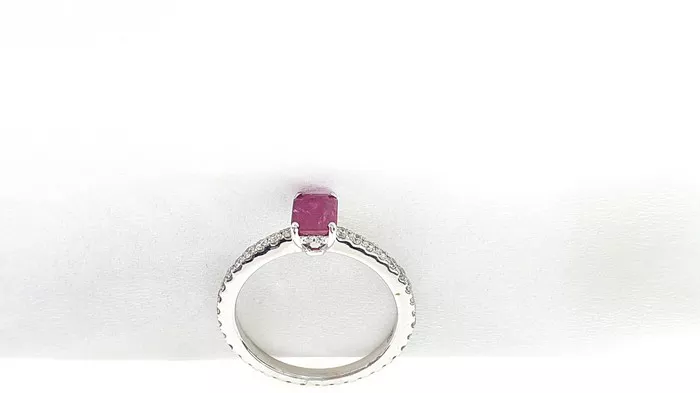Diamond rings have long been synonymous with luxury, romance, and commitment. However, not all diamond rings come with a hefty price tag. Some are surprisingly affordable, raising the question: why are some diamond rings so cheap? To answer this, we delve into various factors that influence diamond pricing, from the intrinsic qualities of the gemstone to market dynamics and production processes.
The Four C’s: Understanding Value
When assessing the value of a diamond ring, jewelers and buyers often refer to the Four C’s: color, clarity, cut, and carat weight. These factors play a crucial role in determining the price of a diamond.
1. Color: The presence of color in a diamond can significantly impact its value. Colorless diamonds are rare and highly sought after, commanding higher prices. On the other hand, diamonds with visible hues are less valuable. The Gemological Institute of America (GIA) grades diamonds on a color scale ranging from D (colorless) to Z (light yellow or brown), with D being the most valuable.
2. Clarity: Clarity refers to the presence of internal flaws (inclusions) and external blemishes in a diamond. Diamonds with fewer inclusions are considered more valuable as they allow for greater light reflection and sparkle. The GIA grades clarity on a scale ranging from Flawless (no inclusions or blemishes visible under 10x magnification) to Included (inclusions visible to the naked eye).
3. Cut: The cut of a diamond determines its brilliance and overall appearance. A well-cut diamond reflects light effectively, resulting in enhanced sparkle and beauty. The GIA grades cut quality based on factors such as proportions, symmetry, and polish.
4. Carat Weight: Carat weight refers to the size of the diamond, with one carat equaling 0.2 grams. Larger diamonds are generally more valuable, assuming other factors such as cut, color, and clarity remain constant.
Diamond Grading and Pricing
Diamonds are graded by reputable organizations like the GIA, which provides standardized assessments of a diamond’s quality based on the Four C’s. These grades serve as a benchmark for pricing, with higher-quality diamonds commanding premium prices.
The grading process involves meticulous examination under controlled conditions, ensuring accuracy and consistency. Diamonds that receive favorable grades for color, clarity, cut, and carat weight are typically priced higher due to their superior quality and rarity.
Market Factors
Supply and demand dynamics also influence diamond prices. Fluctuations in global demand, economic conditions, and geopolitical factors can impact the availability and pricing of diamonds.
Oversupply issues, such as an influx of newly mined diamonds or decreased demand from key markets, can lead to lower prices. Conversely, increased demand or supply constraints may drive prices higher.
Additionally, market perceptions of diamond rarity and desirability can affect pricing. Rare colored diamonds or those with unique characteristics may command premium prices regardless of size.
Production Costs
The cost of mining and processing diamonds plays a significant role in determining their final price. Diamond mining involves substantial investment in equipment, labor, and infrastructure, with operational costs varying depending on factors such as geological conditions and regulatory requirements.
Processing diamonds from rough to polished stones also incurs expenses related to cutting, polishing, and certification. Factors such as labor costs, energy prices, and technological advancements can influence production costs and, consequently, retail prices.
Retail Markups
Retail pricing strategies and markups further contribute to the variability in diamond ring prices. Jewelry retailers typically apply markups to cover overhead costs, including rent, utilities, and staff salaries, as well as to generate profit.
Markup percentages can vary widely depending on the retailer’s business model, brand positioning, and target market. High-end luxury jewelers may command higher markups due to their prestige and exclusivity, while online retailers may offer more competitive prices by operating with lower overhead.
Synthetic Diamonds
The emergence of lab-grown or synthetic diamonds has introduced a new dynamic to the diamond market. These diamonds are created in controlled laboratory environments using advanced technology that replicates the natural diamond-growing process.
Synthetic diamonds offer several advantages, including ethical and environmental considerations, as well as potentially lower prices compared to natural diamonds. While synthetic diamonds may lack the rarity and allure of natural diamonds, they are increasingly sought after by consumers seeking affordable yet high-quality alternatives.
Buying Tips for Value-Conscious Consumers
For consumers looking to purchase diamond rings without breaking the bank, several tips can help ensure value for money:
1. Educate Yourself: Familiarize yourself with the Four C’s and understand how they influence diamond pricing. Research reputable grading organizations and certification processes to make informed decisions.
2. Set Realistic Expectations: Recognize that not all diamonds need to be flawless or colorless to be beautiful. Consider compromising on certain factors such as clarity or color to find a diamond that fits your budget without sacrificing overall appearance.
3. Explore Alternatives: Consider lab-grown diamonds as a cost-effective alternative to natural diamonds. These diamonds offer comparable quality at lower prices, making them an attractive option for budget-conscious buyers.
4. Shop Around: Compare prices from multiple retailers to ensure you’re getting the best deal. Take advantage of online platforms and local jewelers to explore a wide range of options and negotiate pricing if possible.
5. Ask About Financing Options: Some retailers offer financing plans or installment options to help spread the cost of a diamond ring over time. Be sure to inquire about these options and understand the terms and conditions before making a purchase.
In conclusion, the affordability of diamond rings can be attributed to a combination of factors, including the intrinsic qualities of the diamonds themselves, market dynamics, production costs, retail markups, and the availability of synthetic alternatives. By understanding these factors and following practical buying tips, consumers can find diamond rings that offer both quality and value within their budget constraints.

